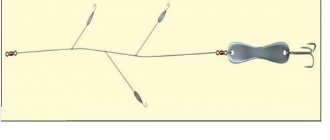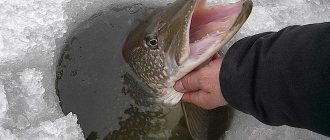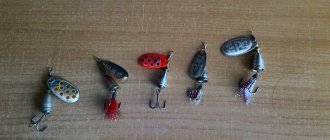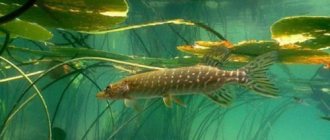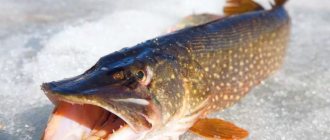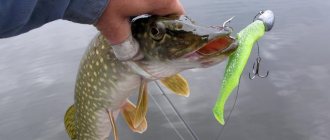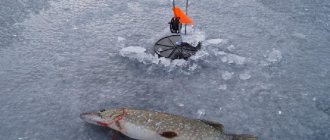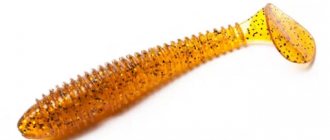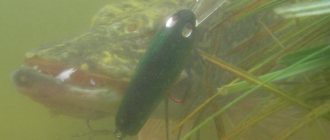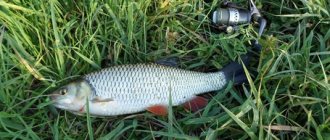What are toad traps and how do you catch pike in them? What baits are used. What’s so good about the “veki” rig... and what is it anyway?
Toads are difficult to catch places that are densely overgrown with aquatic vegetation and often studded with green snags sticking out of the water. And it is not necessary for toads to croak here. Zhabovniks and that’s it...
In autumn, as in spring, all fish strive to gain warmth before the long winter. And even though the predator’s sites are now located in deeper places, pike still go out to hunt in shallow water spots in the depths and in bays, where the water on sunny autumn days still warms up almost to summer temperatures. This attracts small fish here, and greedy predators also rush after the silvery fish.
Peculiarities of pike fishing in toad fields
Often in shallow toad bays, where there is still plenty of vegetation, pike fishing is more effective than on deep-water edges. True, there are difficulties and peculiarities of fishing here. This is primarily due to the fact that you have to fish among thickets of water lilies, reeds and hornwort. Often there are entire colonies of pondweed nearby. This difficulty in casting among the grass requires special baits. And their first specific quality is the ability to avoid snags. These baits include so-called non-hooking baits. But ordinary oscillating spoons with wire spring hook protection are suitable here conditionally only if areas of clean water are found where there is room for placing the oscillator.
Zhabovniki: fishing in shallow waters
"Toadmen".
For some time now, we have been calling shallow water bodies of the lake-marsh type: ponds, floodplain lakes, peat quarries, “polder” canals, etc. In modern spinning jargon, “toad” is the name for pike; at first it hurt the ears, but then we got used to it. “Zhabovniki” have minimal thermal inertia, and therefore they freeze very quickly when the average daily air temperature drops below zero, so the pre-winter period here is very short. In the season close to the average climate in terms of the onset of cold weather, it is possible to catch numbers until the tenth of November on the “toad fish” near Moscow. That is, the winter spinning season (within the framework of how we defined it) on such reservoirs usually lasts only four to five days, but very, very often these days are marked by excellent fishing. At first I did not attach any systemic importance to this. Several times in November I found that today the pike in the “swamp” is very well caught, but tomorrow (or, in extreme cases, a couple of days later) the reservoir freezes over. Then from various acquaintances I learned about many similar cases. I was especially impressed by two stories that took place on the peat bogs near Kadank. One fundamentally differed from the other only in the date - they were separated by six years. Everything else was like a carbon copy: first, several fishing trips with catches from one to four “tails” per brother, then suddenly a crazy bite and a dozen pikes were already a below-average result, and at most a day later - ice. It seems that the pike living in the toad grasses in some incomprehensible way senses the approaching freeze-up - shortly before some biological mechanism turns on, and the pike eats everything. By analogy with the first ice storm, this phenomenon can be called pre-ice storm. The analogy here, however, is quite relative: almost any fish actively feeds on the first ice, while the pre-freeze feeding on the “toad beds” is the prerogative of only pike; even perch, which is found in varying quantities in almost any similar body of water, does not particularly react to the approaching cold wave. Another important factor on which the activity of pike depends is the lunar phase. I believe there is no particular reason to develop the topic and put forward hypotheses on why and due to what this happens, otherwise in the end you can get lost in astrological nonsense like: “Mercury in Capricorn - roaches and bream are biting.” At one time, I conducted a small study of the relationship between pike biting and the phase of the moon, guided by a strict formal statistical approach, and obtained a certain result with a high degree of reliability. Later I compared this result with the forecasts of lunar calendars published in serious foreign fishing magazines, a lot coincided. The volume of statistics that I used in my research did not allow me to make reasonable conclusions about the intensity of the bite hourly - the graph of pike activity I received extended only to the days of the lunar month. To a first approximation, this is sufficient, but it should still be borne in mind that more advanced versions of the lunar fish schedule based on much more comprehensive statistics make it possible to predict changes in the bite intensity during the day with a fairly high probability. Moreover, Casio now even produces special “moon” watches for fishermen with a built-in algorithm that also takes into account the geographical coordinates of the reservoir. The first reviews about the accuracy of the forecast are modestly positive. What should be said right away about the “toad” pike is that it is subject to the influence of the night light to a much greater extent than the same pike, but living in large and deep reservoirs. If we limit ourselves to a simplified diagram of the dependence of its bite on the lunar phase, then it is best caught when the month is growing - when a sickle is visible in the sky in the evenings, which “swells” more and more every day. This favorable period ends on the day when the visible moon reaches half of its disk. The second period of active biting is from the full moon until the moment when the moon “loses” half its weight. In relation to our main topic, the lunar phase interests us not in itself, but in connection with those very few days on the immediate eve of freeze-up: if a “good” moon (especially the one that is waxing) falls on them, the pre-freeze up zhor can be simply fantastic. However, I would not recommend paying primary attention to the moon, especially considering that most of us can only devote weekends to fishing, which, alas, are calculated by the calendar month, and not by the lunar month... Article on the topic: Pike fishing on the river
Lures for fishing in toad beds
The most effective baits for fishing in such places are various silicone worms, best made from edible rubber . These are excellent hook-free fish that are attractive to predators and can slip among the stems and leaves of aquatic vegetation. They may even glide through burdock lily pads. In addition, worms are a natural food for predators, including pike, along with various small fish. In spring, pike and especially squint are often overfed and stuffed with worms, as they say, to the very gills.
For wire fishing, ordinary baits are used, often emerald-colored with shiny elements interspersed. As already mentioned, predators respond better to edible rubber, which usually has an odor and taste. Lures are attached to an offset hook, the tip of which is hidden in the body of the bait. Some similar baits have a special recess-shelf for this purpose.
Autumn. Fishing in toad fields.
Here comes autumn, the real one. The last warm days have given way to damp coolness. The water in the rivers slowly loses temperature, and “pike time” begins. This is true, according to the lyrics. In reality, the pike has been active for the last month without any lyrical digressions. The only question is which pike. The deep channel is a separate, jigging conversation, but now we need to talk about that pike, which in general makes all anglers happy. The last month of summer and part of September my fishing takes place on the Oka. The Oka River is large and there are plenty of different places for fishing, as well as opportunities. At the end of summer, there is one peculiarity - the bleak gradually disperses over the area, and the grown fry - fingerlings - huddle in places where there is denser vegetation and, if possible, warm water. Naturally, shallow water with a relatively weak current always has a warmer regime than rapid high water. It is there, in the presence of vegetation, that the young of the year accumulate, which, in principle, already have quite marketable sizes in the light of the gastronomic interests of various predators.
Toadfish themselves are also different, but we will talk about fishing in specific shallow bays, of which there are quite a few now due to the low water level. Accordingly, this is where your approach to fishing comes from. Given the general trend of a low level, there is still depth here and there. Although it is difficult to call 70 - 80 cm a deep place, but if a bush is located in such a hole, then one hundred percent a pike is “sitting” there, and often more than one. It always surprises me how, at 30-40 cm, an individual, sometimes about a kilogram, finds a place for itself in the grass. However, practice shows that, in principle, this is quite common. Another thing is that it is difficult to offer anything of bait in these conditions without interference. My solution in such conditions is OSP Bent Minnow 86F. Of the three sizes 76-86-106mm, I choose the middle one. The fact is that the grass in the toad grass is still strong and you have to use a fairly thick cord to protect yourself from breaking. In addition, long casting is not important, and is not necessary. Any sane tool guarantees 8-12 meters of working distance, and size 86 is optimal for any predator; even perches eat it, and even more so pikes. Moreover, all kinds of pike “respect” him, regardless of size and age, as they say, “both old and young”
In addition, this “crooked” wolf has its own peculiarity - the front tee is on a concave surface, thereby at least somehow protecting against grass clinging. So fishing 5-7 meters from the water’s edge is quite productive with it.
It’s another matter when in the frogweed you have to move away from the shore at a sufficient distance, about 30-40 meters. Here we already have a slightly different picture. The depth increases to one and a half meters, the bushes are “higher and stronger”, and the grass is located only sporadically. In such conditions, Bent-minnow practically loses its relevance; fighters of a different type are needed. Still, there is more operational space, and the pike are already here more seriously... For this kind of fishing, I have a Black Hole Swift MS-672ML 2.01 m 3-14 g spinning rod, it works within the test limits with all types of baits.
This season, ITUMO Pitty 65 SP in glamorous colors generally shows itself well, and in the pink scenario it is generally a seasonal leader. At the same time, the ITUMO Fatty 70SP acid suspender has always been the leader in terms of pike fishing in the fall. Here, as it were, fishing takes place in a complex. While passing the area on a boat, we carry out the initial actions with Pitty 65 SP, and on the second run we change it to Fatty 70SP, this is where the selectivity of the predator to bait comes into play, because the results show a catch ratio of 60/40.
If you change the baits the other way around, everything will be in approximately the same proportion, perhaps with minor changes. By the way, I went through it a second time and without changing the bait, catches occurred, but these were actually isolated moments. Fishing in frog fields between sand spits is another matter; here the ITUMO Fatty 70SP is beyond competition. I can’t explain why this happens, I have to accept it as a fact. But in any case, combining baits according to their properties gives a purely positive result.
Catching pike with a "veki" (stupid worm)
But in addition to traditional fishing using spinning rods, not long ago a method called “wacky” appeared, which literally translates as “stupid worm”, “stupid worm”. This designation is probably due to the fact that the absurd convulsive movement of the silicone bait resembles a live worm that has fallen into the water . The strangeness and brightness of such movements of the bait are associated with the method of attaching an artificial worm, as if placing a live worm on the hook of a fishing rod, that is, across, so that the ends of the worm dangle and attract fish. Here, too, the silicone bait is planted across , although, of course, you cannot plant the bait with a stocking, like a live worm.
Often such crazy worms arouse much more interest among predators than “tame” baits mounted in the traditional way on an offset hook. It should be noted that for the vac method it is not necessary to use an offset machine . You can use regular hooks, including carp hooks. But special hooks have already appeared for this method of fishing. They have a semicircular shape and are quite large. Hooks designed for weckies are sometimes equipped with special protection, similar to the protection of non-hooking spinners. There are also loaded hooks, similar to microjig heads with a weight of two grams.
Unhooked lures
A worm, which is attached using the weki method, can be thrown not only into areas of water where it is possible to retrieve, but also into windows among vegetation. The very fall of the worm into the water and to the bottom is a rather active game, and often this phase is followed by an attack from a predator. Therefore, wiring is not required here, however, in a small window you won’t be able to wander around too much among the vegetation...
Lures for fishing in toad beds. Kuzmin K.
Lures for fishing in toad bedsKuzmin K.
Summer is in full swing. These are not the best times for pike anglers. In shallow standing reservoirs (the so-called “toad gardens”) there is now a real riot of vegetation. It is extremely difficult to cast bait without attaching grass. But the pike remains active even in such conditions, and achieving the goal of catching it largely comes down to a competent choice of bait. This is a rare case in spinning when the correct selection of bait is more important than technique and tactics. So…
Classic spinners.
Most spinning anglers start fishing with toad baits with conventional spinners or spinners. And they end up with them, because they don’t know anything more suitable. Here I should note that now we are talking about those “toad fields” that are so densely overgrown with grass that for many the very possibility of fishing in them seems absurd. In such places, the use of ordinary lures - in the form in which they are sold in the store - really makes no sense.
If we talk about some borderline case, when there is a lot of grass, but not so much, then with the “classic”, although not without problems, you can catch it. It is only worth making a few comments.
Firstly, the “oscillator” is preferable to the “turntable”. In a “turntable,” the most vulnerable point is often not the tee, but the place where the petal fits on the axis. Even a small blade of grass gets twisted and the spinner no longer rotates. A little more reliable in this regard are spinners with a petal not on the shackle-clamp, but directly on the axis (Elix, Panther Martin), but in principle it is better to refuse both.
If it’s a “oscillator”, then it’s better to be wide and light, that is, made of light metal. From DAM. for example, there is a version of the double “oscillator” “Effzett” - sort of so that the halves jingle against each other. If you halve the spoon, you will get exactly what you need. A wide spoon gives a louder slap when it falls into the water, and this is important when fishing for pike in shallow water.
The open hooks of classic spinners suggest a complete absence of any contact with aquatic vegetation. And this greatly limits their already modest potential for fishing in the “swamp”. Often the casting line passes through alternating two or three spots of open water and strips of grass, which there is no way to get around. Sometimes it is possible to make the spoon jump over an obstacle, but more often than not the first green obstacle makes all the remaining meters of wiring meaningless.
The most recent case, clearly confirming the shortcomings of classic spinners, took place a week ago at Zhabovnik in the Danube Delta. The Romanian huntsman fished, as usual, with a “shaker”, and even with an additional double on the front ring. It was clear that his hand was full of such fishing. But there was no point in casting the lure further than fifteen to twenty meters, since it invariably collected bunches of grass, and the pike did not take it close to the boat that day - probably because of the quiet weather. It ended up that the huntsman stopped all attempts to catch fish and began to simply watch how, with the help of unhooked hooks, we got pikes from a distance of 50-60 m - from places that simply could not be caught with baits with open hooks...
Oscillating spinners without hooking.
In the assortment of many companies (Kuusamo, Aise, DAM, etc.) you can find from one to several models of “oscillators” with hooks protected by wire “whiskers”. The hook (double or single) is most often rigidly fixed to the spoon.
It seems that such spoons are not very different from ordinary “spinners”, but when it comes to working on “toad spinners”, the difference is colossal! At least they can solve the problem of tough herbaceous vegetation (water lilies, sedge, etc.) almost completely. You just need to keep an eye on the position of the “whiskers” - after dragging through the thickets and especially after bites, they can bend and then a snag cannot be avoided. The optimal position of the “whiskers” is such that they rise a millimeter above the stings of the hooks.
With soft grass, oscillating non-hooking baits do not always cope - the grass often clings to both the front part of the spoon and the hooks themselves, despite their protection.
Rapala Minnow Spoon.
The very original idea embedded in this unique bait deserves the highest praise.
The density of the material is slightly higher than the density of water, therefore, when casting, the Minnow Spoon has a very significant weight, which ensures long range, while the weight is significantly less, which allows for slow retrieve.
In relation to fishing on overgrown toad grasses, we are more interested in the version of this bait with a fixed single hook covered with a wire “whisker”. Another variant of the Minnow Spoon is also possible, in which, instead of a tee, a single is suspended on a winding ring - either offset, or with a wire loop covering the tip, and a twister is attached to the single.
A Minnow Spoon with a single fixed hook should also be fitted with a twister. True, such a bait with a bait looks somewhat strange - the twister seems to stick out to the side, but with a twister it is better than without - this has been tested many times on a variety of reservoirs. The twister allows you to slow down the wiring even more, and this has a positive effect on the bite, and “toadfish” in particular.
Minnow Spoon can be dragged through any grass. Its cross-country ability is higher than that of “oscillators” with “mustaches,” but, of course, it is not one hundred percent. If filamentous algae is encountered along the bait’s path, then effective fishing ends there. Yes, and grass like elodea sometimes gets stuck. But in general, Minnow Spoon behaves very well in the “toads”.
Repeated bites are very typical for it. After the pike attacks the bait, and with tangible contact, but does not sit on the hook, it can attack the bait again on the next cast or even on several casts in a row. So, with Minnow Spoon the probability of repeated bites is higher than with many other artificial baits.
It’s a shame that Rapala discontinued the Minnow Spoon; buying one will soon become almost hopeless. True, there are “left-handed” baits, very similar in appearance, that come from China and from our country, but I can’t say anything about their working merits - I haven’t tried them.
Poppers, walkers, etc.
These baits are purely surface baits. They work very well for pike in summer and autumn, but not nearly as effectively as we would like and not everywhere.
Despite the fact that poppers (and their analogues) are almost always equipped with two uncovered tees, the number of empty bites and fish misses when fishing with them is unreasonably high. You could see this in the corresponding film of the “Modern Spinning” series, and you yourself, perhaps you have encountered this.
Regarding the limitations - for normal wiring, poppers require at least a ten to fifteen centimeter layer of algae-free water. Below there can be a real jungle, but a clean top layer is a necessity. Even those varieties of poppers that are equipped with only a single tail hook cannot be carried out where the grass reaches the very surface.
Poppers can be effective where there are windows in the grass. Even if the size of the window is such that the popper only manages to gurgle two or three times, this may be enough to provoke a pike bite. In this kind of fishing, the main thing is a careful approach to the fish (after all, you have to fish from close range) and accuracy in casting.
Spinner baits.
Lures of this variety bear little resemblance to anything else and, more importantly, bear little resemblance to real fish, which is why spinning anglers do not immediately trust them. If you happen to catch it on a spinner bait, and even where there was no bite on anything else, then all doubts will be dispelled.
Now we are talking about the classic shallow-water variety of spinner bait, which is made on a wire arch with a rigid fastening of the lower part. Another common option - with a jig head attached through a fastener - is less suitable for fishing on grass.
The main area of application of a spinner bait is vertically oriented vegetation: places on a reservoir with sedge, reeds, etc. Of course, we are talking about vegetation that does not stand tightly together as a wall, but rather scattered, with baits of traditional types and sparse the grass does not manage to avoid hooks, but the spinner bait passes freely - due to the fact that the hook is shielded by a wire rocker, and the loading has a streamlined geometry.
A pair of large rotating petals is perceived by fish from a long distance, so fishing with a spinner bait does not necessarily require casting close to the predator’s parking areas.
The ratio of pike and perch to the spinner bait on a particular “toadfish” cannot be predicted. It happens that this bait catches so much that you don’t even remember about others. It also happens the other way around - it bites, to one degree or another, on almost everything that is, in principle, suitable for fishing in such conditions, but on a spinner bait - zero. Anyway. The spinner bait should be in place in your bait box - try it and come to one conclusion or another.
Plastic worms and other rubber.
The version of the plastic worm rig, which is commonly called “Texas”, is precisely designed for fishing in extremely “harsh” conditions, that is, where there is a lot of things that a hook or some other part of the bait can catch on. The fact is that the Texas rig works great for bass. I had the opportunity to make sure, but now we are talking primarily about pike, and here everything is not so good.
Yes, the “Texas” worm can be pulled through any grass, but in terms of the number of bites it is far from being in first place when compared with other “swamp” baits. The fact is that the “Texas” worm lacks visibility.
If you remember, when characterizing oscillating spoons, I noted among their advantages the “slap effect” when falling on the ox. This in itself often provokes a pike attack. A plastic worm, on the contrary, falls into the water with minimal sound, and this is a significant disadvantage in our case.
You can add visibility to the worm by increasing its size to twenty centimeters. For perch this is already too much, but for pike it’s just right.
What is also important is that a large plastic worm has enough mass for a full cast without additional burden. In other words, you can do without a bullet head or some other weight. Only a worm on an offset hook - and nothing else, except for a small steel leash.
You can also remember about slug-type baits, which, in principle, are used without weights. But both the slug and the “Texas” worm when fishing for pike on the “toadfish,” I repeat, give fewer bites than lures of other varieties. And there are problems with the implementation of these bites - due to the offset hook ...
In some places you can fish on the grass with the classic twister rig - on a small jig head, only the head should be streamlined in geometry and with a fastening ring not on top, but in front. This type of equipment can be dragged through grass lying at some depth - not always, but often enough to keep it in mind. True, rigging a “rubber” bait of this type has never given very good results when fishing in a “swamp”, but the opposite examples are also known.
Hydroplane.
I made my first glider a little over two years ago. I did this out of desperation: having once arrived for fishing, I suddenly discovered that the water in the polder canals had been abruptly dropped, and the grass, which had previously been located below the surface, was now in many places simply lying on it. Particular troubles came from the mud - if its spots and stripes could not be avoided, then the bait invariably collected a dark green tail, which had difficulty getting rid of every time, since filamentous algae clung to everything that protruded even a little. Neither the Minnow Spoon, nor, especially, the non-hooking devices of other designs worked in such conditions. Something fundamentally new was needed.
This new one was the glider. Its idea is quite simple: a body in the form of an iron with loading from below closer to the tail and a large single hook, rigidly fixed in the vertical plane. When falling onto the water, the glider in the vast majority of cases touches the surface with its lower part. Even if it falls into the mud, this does not lead to anything particularly unpleasant - the glider glides over the surface as soon as it begins to drive - and it doesn’t matter whether it is clean or with any kind of vegetation. There are, of course, exceptions, but most often the glider passes on any green surface without any problems.
Ideally, the glider should sink slowly. When rewinding, it slides along the surface, but if you pause, it sinks, and when rewinding resumes, it comes to the surface again. If the path of the bait passes through a sequence of patches of grass and open water, then in clear water it is useful to stop reeling - sometimes the pike follows the glider and attacks it at the moment it stops
My first homemade gliders were made as simply as possible. Later, when the Aise company began producing baits of this type, I sometimes began to hook a twister. I don’t think that such an addition directly helps to improve the bite, but it is a fact that a planer with an addition sinks more slowly. It seemed to me that the two Aise gliders I fished with were a little heavier than necessary, so I added rubber tails to them.
The Aise gliders are made with an obvious hint - like imitation mice: the color is appropriate, and one of them even had a purely mouse tail attached. By the way, I tore off that tail and threw it away, but I advise you not to be tormented by doubts whether the pike eats mice or not. She “eats” gliders – this has been tested many times on a variety of “toads”.
“Spreader” with soft bait on a hook.
Take a small oscillating spoon, preferably medium-wide, and instead of a tee, attach a non-hooking foam fish with a pressed double, or some other design. Thus, you will get one of the best baits for fishing in the toad field.
The fundamental difference between such a bait and the “foam rubber” with which we fish using the jig method at depth is only that instead of a “eared” weight there is a “stake beam”. And in this case, this difference is of enormous importance.
In its operation, a “shaker” with a “foam rubber” is similar to a glider. Already at a fairly slow reeling, if you raise the tip of the spinning rod higher, the bait comes to the surface and slides along it. At stops, naturally, she dives.
The volumetric “foam rubber” seems to dampen the movements of the oscillating spoon, so the spoon on the fly only barely rolls from side to side.
Instead of foam rubber, you can use a silicone bait on an offset hook, but I still prefer foam rubber. Perhaps because it was with the “foam rubber” that I achieved the most impressive results.
In the case that I described at the beginning of the article - when the Romanian huntsman himself stopped fishing and then carefully examined our baits - the greatest effect was produced by an oscillating spoon (Little Cleo) with a “foam rubber”. You could throw it anywhere, and pikes were thrown from all imaginable directions. This is despite the fact that there were an order of magnitude fewer bites with other baits...
Dead fish... without tackle.
The phrase “dead fish on a rig” has long become commonplace. There are a great variety of tackles, and new ones are constantly being invented.
The design that I sometimes use when fishing in “toad fisheries” is simply hard to call a “rig”. This is a steel leash, a double and a piece of soft copper wire.
The leash is inserted into the fish's mouth and removed through the gills; a double is put on the ring of the leash, one of the hooks of which is fixed in the body of the fish, the other is pressed against it. In the head part, the fish is wrapped with several turns of copper wire to prevent it from slipping.
Deprived of additional loading, a dead fish sinks very slowly. The absence of protruding hooks allows you to fish with it among the grass. Posting is slow, with delays. There are a lot of bites. You don’t need to hook right away, but just like when fishing with live bait - by giving up a little line and pausing, usually about five to seven seconds. Perhaps a soft leader is preferable in this type of fishing, but I have always fished with my traditional guitar string and had no reason to complain.
Fishing for pike in the toads. Tackle.
Before we begin our discussion on this topic, let’s first define what a toadgrass is. Most anglers define this concept as a small, heavily overgrown body of water without a current. Bays, floodplain lakes, shallow ponds, etc. can act as toadweed. Contrary to false opinions, you can count on good fishing in the frogs - there is always fish there, and in large quantities. This is explained by the fact that there is very little pressure from poachers, or none at all. On toad plants they will get 10 kg of grass per 1 kg of fish. For the float fish, the toadstool is a wonderful place where you can successfully catch crucian carp, link, rudd, roach and other peaceful fish. There is also room for a spinner to roam. It’s great to catch perch, rudd and, of course, pike. In general, I consider it the main object that should be hunted for toads. The perch grows small, the rudd is not found everywhere, and to catch it you need to try hard. But the toothy one pleases with its size and bite. Well, maybe, of course, I was lying about the “pleasant size” (usually the weight of the trophies caught ranges from 100 to 4000 grams), but the bite on her frogs has really been cancelled.
A reliable, powerful reel is the key to successful fishing
Fishing in these conditions is difficult and associated with constant discomfort. On almost every fishing trip, at first you will pull out “green crocodiles” on bait - huge bunches of algae. Leave a few baits in the grass a couple of times - not without it. Based on all of the above, we need to select gear. The spinning rod should be short and powerful so that you can forcefully fish out the pike, tearing it through the grass. Give up the idea of fishing on toad grasses with light, and especially ultralight, right away. Out of my stupidity, I somehow decided to hunt for pike in one small floodplain lake, which was completely overgrown with algae. And I decided to use a stick with 3-15 grams of dough. Due to the fact that clear water barely reached the 20 cm mark, it was decided to install a crossbar. Popper was expensive and very rare at that time. A good bait and correct wiring did their job - the pike attacked the popper. At first impressions it is small, about 1 kg. After about three seconds, her narrow body leaked into the dense underwater jungle. The spinning rod bent and the reel stopped reeling in the line. For a very long time I tried to drag the island of grass to the shore, in the hope that my pike was still fluttering on the hook there. Then I forgot about the toothy one and dreamed of saving the wobbler. When the fishing line could not withstand the enormous weight of the greenery that I was trying to drag towards me and it finally burst, anger and despair settled in my heart. I even wanted to swim for the popper, but then, remembering that swimming in the frogs is certain death, I resigned myself to the loss. Choose a powerful spinning rod with a test weight of at least 5-25. Medium-fast action is most suitable for the conditions considered.
The reel must be powerful and reliable. It will bear most of the loads during power fishing, and it must work flawlessly. Size 3000-4000 thousand according to Shimano classification is ideal. Pay special attention to the operation of the friction brake. It should deliver the line without jamming, and exactly as much as needed. In addition, it is necessary to make sure that the line guide bracket is securely fixed, that there are no backlashes, etc. For fishing in difficult conditions, toadstool should be used with a braided line. It has a greater safety margin compared to monofilament. When you pull a 3-kilogram pike ashore, preventing it from going into densely overgrown areas, you must be confident in the strength of your own gear, and not scroll through thoughts in your head (will the cord hold up? Spinning... This will only interfere with your fight. So take braided line, and three times stronger, just to be sure. The optimal thickness of the cord is 0.22-0.28. With such a fishing line, you can be sure that the trophy will end up on the shore.
For fishing in the toadstools, it would be nice to have one good piece of fishing equipment - waders or waders. With them, your capabilities will increase several times, and dozens of baits that were accidentally left in the grass or on the reeds will be saved. Regarding the selection of gear - that’s it. In the following materials we will talk about what baits to use in such conditions and how to retrieve them. Let's also get acquainted with the technique of forced pike fishing. To be continued…
Fishing for pike in the toads. Lures
Continuing the conversation about catching toothfish in toad grasses, I consider it necessary to move on to a discussion of baits that are most often used when fishing in thickets of reservoirs.
Popper is a wonderful bait for fishing overgrown reservoirs
Before selecting lures for catching pike in shallow water, let's decide what properties they should have. Due to the fact that in most floodplain lakes, ponds and bays the layer of algae almost reaches the surface layer of water, fishing with classic jigs, cranks, and suspender minnows is completely excluded. All of the listed baits perform excellently in reservoirs, rivers, and large lakes, but they are completely unsuitable for fishing in toad fields. Here you need to arm yourself completely differently.
I’ll start my review of shallow water baits with wobblers. For fishing on toadworts, two types of wobblers are best suited - “zero-wobblers” (zero-wobblers) with a slight immersion (up to 0.7 m... The reasons for using these particular baits are clear - they will not collect tufts of grass on every cast. In general, the wobblers in question are not the best lures for summer fishing. At this time, pike rarely show activity, and therefore react weakly to actively playing baits, which are the majority of “zeros”. It would be more advisable to fish at this time with spoons, suspender minnows, which are excellent killers of passive toothy, but in the conditions under consideration, they turn into a tool for reducing the algae population. Therefore, you have to use something that allows you to reduce the number of hooks to a minimum. The specificity of catching pike with granule wobblers in the summer is to provide them with the lowest retrieve speed. It is also worth completely abandoning silent baits, and give preference to models with acoustic systems.Why all this - noise, slow wiring, and even sometimes stops? And all this in order to increase the number of effective bites. Pike in toad grasses stay directly in the grass thickets, and do not visually notice the bait at all. The main organ it focuses on is the lateral line. The wobbler attack occurs on an intuitive level, and is often not crowned with success. Slow retrieving and stopping will greatly increase the efficiency of fishing.
If the depth clear of grass is 50-70 cm, then you can successfully use wobblers with a depth of up to one meter and some models of minnows. You should choose models with bright colors - green-yellow, orange, red, etc. An acoustic camera is also a must. Don’t do the wiring very slowly—it’s best to do it at a medium pace. As practice shows, pike misses less often in these conditions.
Fishing with poppers and stickbaits is very interesting. In terms of catchability, they are not superior to previous types of wobblers, but they are much more spectacular. After all, the bite occurs directly in front of the fisherman’s eyes, and the adrenaline rush is simply colossal. When choosing models, pay attention to the fact that the belly is bright in color. This bait is more noticeable to a predator who sees it from below. In retrieving these baits, pauses play a much greater role than active actions. After splashdown, there are 3-4 jerks and a long pause, during which the bite most often occurs. After this, the number of jerks should be reduced to 1-2, and the pause should be maintained for 4-5 seconds.
I consider lightweight spinners to be one of the clear favorites among lures for catching summer pike. What are they? These are ordinary spinners without a central core. Instead, a copper wire is wound around the axis, or plastic beads are put on. Due to the fact that the weight of the spinner is too small, it often spins around its axis, thereby twisting the line. A twisted line is 100% a beard, and a beard is a spoiled mood when fishing. So that your mood is not spoiled in the most ugly way, it is necessary to equip the tee with a large fly made of woolen thread. The windage increases, and it is more difficult for the lure to spin.
You can also do the following: slightly bend the axle closer to the front eyelet. In this case, the displaced center of gravity will interfere with rotation around its axis. It is best to use these two methods simultaneously - then beards and bad mood will be kept to a minimum. And of course, don’t forget about the main anti-twist – the swivel. This small piece of equipment is perhaps the most effective tool of all time. Start wiring the lightweight turntable immediately after splashdown. The best results are obtained by fishing at the lowest reel speeds, although sometimes it is necessary to speed up the reeling. I can’t say in what situations this is necessary. You yourself must learn to feel what, how and when to do. This is the first and main component of success.
There are usually a lot of pike in the fronds

